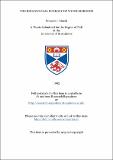Files in this item
The behavioural ecology of young baboons
Item metadata
| dc.contributor.advisor | Whiten, Andrew | |
| dc.contributor.author | Marsh, Frances J. | |
| dc.coverage.spatial | 350 p., 14 p. of plates. | en_US |
| dc.date.accessioned | 2018-07-09T09:48:34Z | |
| dc.date.available | 2018-07-09T09:48:34Z | |
| dc.date.issued | 1993 | |
| dc.identifier.uri | https://hdl.handle.net/10023/15097 | |
| dc.description.abstract | It is hypothesised that young baboons are potentially vulnerable to the effects of seasonal stress. Data were collected on the behaviour of this age group during a 12 month field study of a troop of olive baboons (Papio anubis) on the Laikipia plateau, Kenya, using a hand-held computer and a new program written by the author. Long-term environmental records for this site were continued. At this site there is a seasonal pattern of rainfall with inter-annual variation. Measures of biomass indicate that there are seasonal fluctuations in baboon food availability. Patterns in the occurrence of one component of the baboon's diet, Acacia species, are presented. The varying behaviour of the troop as a whole is related to food availability. Differential use of the home range and observed sub-trooping behaviour are interpreted as adaptive strategies for living in a seasonal environment. Developmental change in the behaviour associated with the mother-offspring relationship is described. Patterns in the time spent in contact with and close proximity to the mother from this site are compared with those from other sites, and striking similarities are found. Many of the behavioural activities of infants and young juveniles, i.e. feeding, moving, types of exploring, visually attending, grooming, and receiving affiliative approaches, exhibit patterns of developmental change. Interactions between activities are examined in the context of the complete activity budget. The effect of seasonal stress on young baboons is examined by using a technique of curve fitting. Data are compared between periods of higher and lower food availability. Significantly more time is spent feeding and less time spent in social and attending activities in the 'worst' than the 'best' months. Young baboons vary their diets seasonally. There is evidence that older infants (weanlings) are more vulnerable to the impact of seasonal stress than either young infants or young juveniles. | en_US |
| dc.language.iso | en | en_US |
| dc.publisher | University of St Andrews | |
| dc.subject.lcc | QL737.P93M2 | |
| dc.subject.lcsh | Cercopithecidae (Old World monkeys) | en |
| dc.title | The behavioural ecology of young baboons | en_US |
| dc.type | Thesis | en_US |
| dc.contributor.sponsor | Biotechnology and Biological Sciences Research Council (BBSRC) | en_US |
| dc.type.qualificationlevel | Doctoral | en_US |
| dc.type.qualificationname | PhD Doctor of Philosophy | en_US |
| dc.publisher.institution | The University of St Andrews | en_US |
This item appears in the following Collection(s)
Items in the St Andrews Research Repository are protected by copyright, with all rights reserved, unless otherwise indicated.

